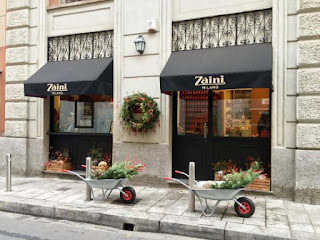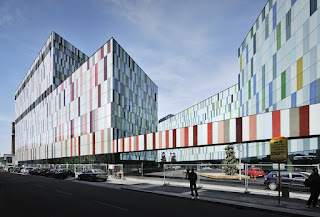Inventor of Baci chocolates who diversified into fashion
 |
Luisa Spagnoli became the driving force of Perugina
chocolates after Italy entered the First World War |
The businesswoman Luisa Spagnoli, who is credited with creating the Perugina company’s famous Baci chocolates and later developed clothing lines using wool from angora rabbits, was born on this day in 1877 in Perugia.
Spagnoli was one of the four partners who launched the Perugina brand in 1907. She is said to have invented the confection that came to be known as Baci as a way to avoid wasting surplus chocolate and hazelnuts left over from the company’s other lines.
Perugina, now owned by Nestlé, grew to be Italy’s biggest chocolate manufacturer and Baci its best-selling product. The romantic messages inside the wrappers that remain a popular feature of the chocolates to this day are said to have been inspired by the clandestine romance between Spagnoli and the son of one of the other partners.
Her Angora Spagnoli business evolved into the Luisa Spagnoli fashion line that was developed by her son, Mario, and grandson, Lino, who took the business forward after Luisa had died in 1935, at the age of just 57.
Spagnoli was born Luisa Sargentini, the daughter of a fishmonger, Pasquale. After leaving school at 13 to work on the accountancy and commercial side of her father’s business, she was married at the age of 21 to Annibale Spagnoli.
She went into business with her husband when they took over the running of a grocery store in Perugia. They produced their own sugared almonds to sell in the store, expanding into jams, confectionery and chocolate.
 |
Today's Baci chocolates are still produced
according to Luisa's 1922 recipe |
In 1907, Annibale and Luisa joined up with pasta manufacturer
Francesco Buitoni and another businessman, Leone Ascoli, in launching
La Società Perugina.
The first product line was sugared almonds, but recognising the potential of chocolate they opened a factory at Fontivegge, near the city’s railway station, which produced cocoa powder and cocoa butter.
Italy’s entry into World War One in 1915 brought profound changes. After the men were enlisted to do military service, Luisa found herself in charge of the business. As resources became limited, Luisa turned her focus to chocolate, blending caramelised sugar with cocoa to produce a 51% dark chocolate.
Sugary sweets were defined by the Italian government as superfluous, luxury goods as they tried to avoid shortages and their production was prohibited, but Luisa priced her chocolate bars at a level that meant they were available to all and could not be classed as luxuries. For good measure, boxes of bars were sent to fortify Italian soldiers on the frontline.
In 1922, Annibale Spagnoli left the business, apparently because of internal friction within the company. Luisa remained, running the business jointly with Francesco Buitoni’s son, Giovanni.
 |
Giovanni Buitoni, with whom Luisa
had a clandestine romance |
It was in the same year that Baci chocolates was born. Ever resourceful, Luisa was determined that the surplus chocolate and hazelnuts left at the end of each batch of bars produced would not be thrown away. She had the idea to use the excess to make small, individual chocolates, wrapping chocolate round a blob of chopped hazelnuts and gianduja - a concoction of chocolate and hazelnut paste - topped with a whole hazelnut.
She thought the sweet resembled a clenched fist and decided to call it a cazzotto - the Italian word for punch. Giovanni, however, thought it was an inappropriate name for something meant to give pleasure and suggested bacio, which is Italian for kiss.
Buitoni was 32 and Luisa 46 but despite the age gap - and the fact that Luisa was already married - a romance developed between the two, which was to continue clandestinely for the rest of her life. While they were working together in the factory, she would secretly wrap love notes around chocolates as she sent them to Giovanni to taste.
These became the inspiration for the way Baci were marketed - chocolate kisses with a romantic note attached as the perfect present for young lovers.
At a time when women in business were a rarity, Spagnoli proved herself not only to have a shrewd commercial brain but also to be one of the most forward-thinking bosses of her age.
She had houses and a swimming pool built for Perugina’s workforce and organised leisure activities to aid their wellbeing. During the war, she provided a nursery so that female employees with young children could continue to work even when their husbands were away at the front.
 |
The fashion stores opened by her son,
Mario, carry his mother;s name
|
Her first moves into the fashion business came at around the same time as
Baci were born as she began breeding long-haired angora rabbits, from which wool could be produced not by shearing their coats but simply by combing. She set up a production plant in the Perugia suburb of
Santa Lucia, where the wool was used to make shawls, boleros and other fashionable garments.
After a favourable reception when she showed off her products at the Milan Fair, she recruited a network of 8,000 breeders to supply the business.
Sadly, Spagnoli did not live long enough to see her fashion enterprise reach its potential. Diagnosed with throat cancer, she moved at Giovanni’s insistence to Paris in order to receive the best care available but died there in 1935.
Two years after her death, Mario Spagnoli - one of three sons she had with Annibale - turned Angora Spagnoli from a small, artisan concern to industrial scale production, opening a new factory in Santa Lucia. Later, together with his son, Annibale - known as Lino - they opened a network of Luisa Spagnoli fashion stores, which still exist today.
In the 1940s, at a time when many Italians suffered from hunger and cold thanks to the deprivations of war, Mario maintained his mother’s spirit of generosity towards the workers who helped generate the company’s profits, making sure their efforts were rewarded with a Christmas gift of shirts, socks and wool to a value of 4,000 lire, a considerable sum at the time.
His mother is buried in the crypt adjacent to the Santa Lucia factory. Her name lives on, though, in the packaging on Baci chocolates - still in the blue of the originals - with the subtitle 'Fondente Luisa', while the Perugina 51% dark chocolate bar is still marketed as the Perugina Luisa bar.
 |
Piazza IV Novembre is the main square of the
Umbrian capital, Perugia, where Spagnoli was born |
Travel tip:
Perugia, the capital of the Umbria region, is an ancient city that sits on a high hilltop midway between Rome and Florence. In Etruscan times it was one of the most powerful cities of the period. It is also a university town with a long history, the University of Perugia having been founded in 1308. The presence of the University for Foreigners and a number of smaller colleges gives Perugia a student population of more than 40,000. The centre of the city, Piazza IV Novembre, has a mediaeval fountain, the Fontana Maggiore, which was sculpted by Nicolo and Giovanni Pisano. The city’s imposing Basilica di San Domenico, built in the early 14th century also to designs by Giovanni Pisano, is the largest church in Umbria, with a distinctive 60m (197ft) bell tower and a 17th-century interior, designed by Carlo Maderno, lit by enormous stained-glass windows. The basilica contains the tomb of Pope Benedict XI, who died from poisoning in 1304.
 |
Perugia's historic
Pasticceria Sandri |
Travel tip:
Luisa Spagnoli’s main store in Perugia is in Corso Vannucci, right in the heart of the city, which connects Piazza IV Novembre with Piazza Italia. The street takes its name from Pietro Vannucci , a painter born in Città della Pieve and best known by his nickname Il Perugino. His frescoes decorate the Palazzo dei Priori, one of the most important buildings on Corso Vannucci along with the 15th century Palazzo dei Notari and the House of Baldo degli Ubaldi, the deconsecrated church of Sant'Isidoro and the Palazzo Donini. The street is also home to the historic Pasticceria Sandri, which has been trading there since 1860.
Also on this day:







.jpg)
.jpg)


.jpeg)














